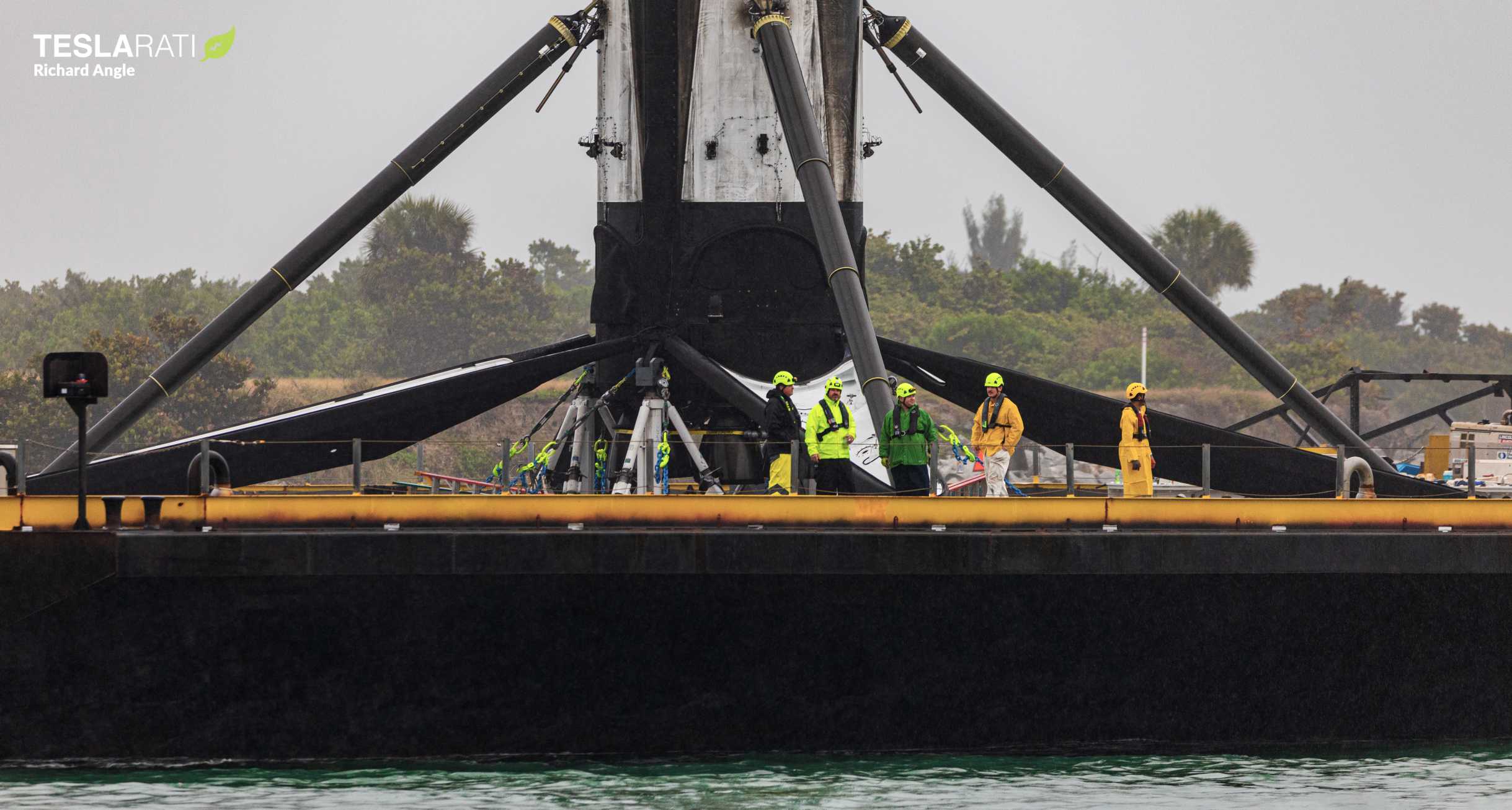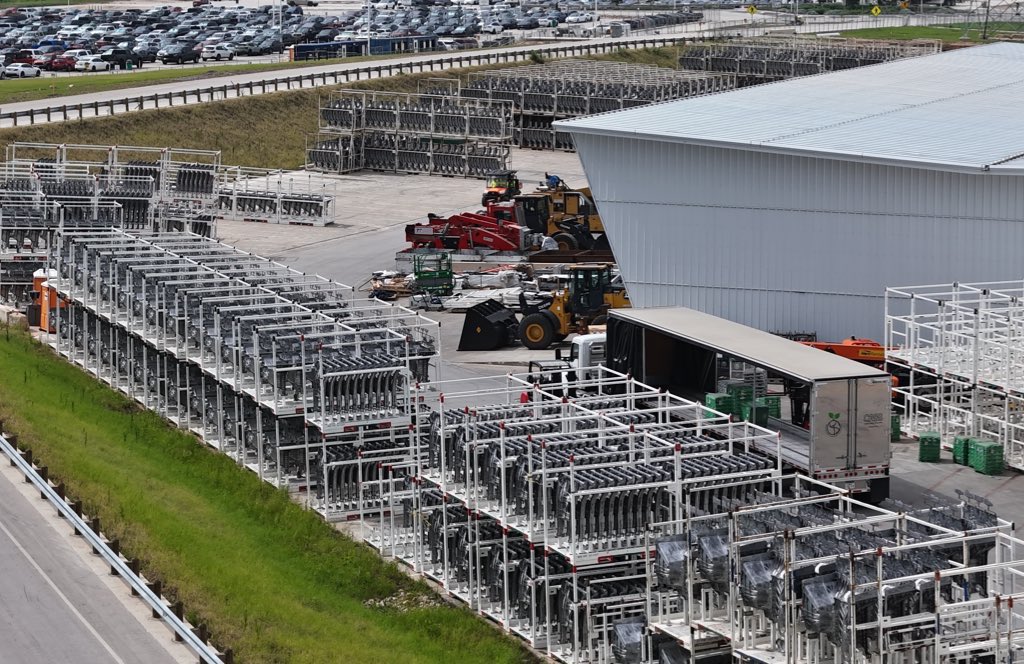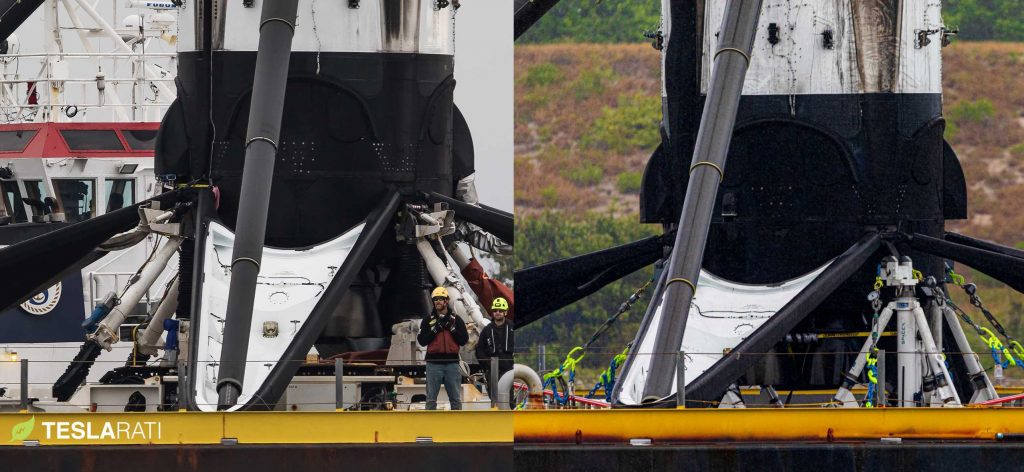

News
SpaceX rocket booster makes it back to port after hard drone ship landing
SpaceX has completed its third rocket launch of 2020 and the most recent booster to launch safely returned to Port Canaveral on Saturday after an exceptionally hard drone ship landing.
Falcon 9 booster (first stage) B1051 lifted off for the third time on January 29th, following up two prior orbital-class missions by placing SpaceX’s fourth batch of 60 Starlink satellites into low Earth orbit (LEO). B1051 debuted on March 2nd, 2019 when it became the first Falcon 9 rocket to launch SpaceX’s next-generation Crew Dragon spacecraft, successfully sending the vehicle on its way to what would end up being a flawless rendezvous with the International Space Station (ISS). Less than four months later, B1051 completed its second mission, this time lifting off from SpaceX’s Vandenberg Air Force Base (VAFB), California facilities before landing in zero-visibility fog conditions just a thousand feet from the pad.
Compared to some of the higher-energy geostationary (high orbit) launches SpaceX often performs, B1051’s two prior launches allowed for relatively gentle reentries and landings. On January 29th, 2020, after sending SpaceX’s 3rd batch of upgraded Starlink v1.0 satellites (Starlink V1 L3) on their way to space, the Falcon 9 booster experienced the hardest successful landing seen after a SpaceX launch in quite some time.
With Starlink V1 L3 complete, SpaceX has officially launched an incredible 120 satellites weighing some 32 metric tons (70,500 lb) in a single month – 22 days, to be precise. If everything goes as planned, those two monthly Starlink launches should become SpaceX’s average over the rest of 2020, necessary to satisfy the company’s goal of completing 20-24 Starlink launches this year alone. If SpaceX replicates its January successes this month, the company’s Starlink constellation – already ~230 satellites strong – may even be ready to start serving internet to customers in the northern US and Canada as early as March 2020, less than two months from now.



Meanwhile, the mission marked SpaceX’s second Falcon 9 landing and recovery of the new year, as well as the sixth time an orbital-class SpaceX booster has completed three launches. SpaceX continues to push the envelope of reusable rocketry ever since it debuted Falcon 9’s Block 5 upgrade in May 2018.
Designed to enable no less than 10 launches per booster with minimal refurbishment in between, SpaceX’s Block 5 reusability milestones have gotten much closer together ever since the company began dedicated Starlink launches, reusing a payload fairing for the first time and launching two Falcon 9 boosters for the fourth time in just the last two and a half months. In fact, SpaceX already has plans to launch Falcon 9 booster B1048 for the fifth time – another major reusability first – as early as the next 4-5 weeks.
Hard landing; tough rocket
Starlink V1 L3’s launch followed a trajectory almost exactly identical to the two V1 missions that preceded it in November 2019 and January 2020 and Falcon 9 B1051 ignited its central Merlin 1D engine for the last time around eight minutes after liftoff. Twenty seconds or so later, the Falcon 9 booster rapidly shut down its landing engine, visibly falling several feet onto the deck of drone ship Of Course I Still Love You (OCISLY).


The results of that unintentionally hard landing are extremely apparent in photos taken of the same booster after its first (March 2019) and third (Jan 2020) landings on drone ship OCISLY, compared above. Taken from almost identical perspectives as the drone ship passed through the mouth of Port Canaveral, the difference in the booster’s height and stance are hard to miss, with B1051’s engine bells and the black ‘belt’ of its heat-shielded engine section clearly sitting several feet lower after Starlink V1 L3.
While subtle, the most important difference is near the tips of each visible landing leg’s telescoping boom, visible in the form of a final, smaller cylinder on the left (earlier) image. On the right, that cylinder has effectively disappeared. This is actually an intentional feature of Falcon 9’s landing leg design: known as a ‘crush core’, the tip of each leg boom holds a roughly 1m (3ft) long cylinder of aluminum honeycomb, optimized to lose structural integrity (crush) only after a specific amount of force is applied. In essence, those crush cores serve as dead-simple, single-use shock absorbers that can be reused as long as a given booster’s landing is gentle enough.
B1051’s third landing was definitely not gentle enough, but it appears that the booster’s rough fall onto the drone ship’s deck was just within the safety margins those crush cores provide. Why B1051 fell onto the deck is unclear, potentially caused by the drone being at the bottom of a swell or a last-second anomaly with the booster’s landing engine. Thankfully, regardless of the cause of the anomaly, B1051’s crush cores can be quite easily replaced, meaning that the booster can remain operational as long as its hard landing didn’t cause any less-visible damage or stress elsewhere on the rocket.
In short, SpaceX smart design decisions very likely allowed a part worth just a few thousand dollars to save a Falcon 9 booster worth tens of millions of dollars from the scrap heap. With a little luck, B1051 should have at least several more launches in its future before entering retirement.
Check out Teslarati’s Marketplace! We offer Tesla accessories, including for the Tesla Cybertruck and Tesla Model 3.
News
These Tesla, X, and xAI engineers were just poached by OpenAI
The news is the latest in an ongoing feud between Elon Musk and the Sam Altman-run firm OpenAI.

OpenAI, the xAI competitor for which Elon Musk previously served as a boardmember and helped to co-found, has reportedly poached high-level engineers from Tesla, along with others from xAI, X, and still others.
On Tuesday, Wired reported that OpenAI hired four high-level engineers from Tesla, xAI, and X, as seen in an internal Slack message sent by co-founder Greg Brockman. The engineers include Tesla Vice President of Software Engineering David Lau, X and xAI’s head of infrastructure engineering Uday Ruddarraju, and fellow xAI infrastructure engineer Mike Dalton. The hiring spree also included Angela Fan, an AI researcher from Meta.
“We’re excited to welcome these new members to our scaling team,” said Hannah Wong, an OpenAI spokesperson. “Our approach is to continue building and bringing together world-class infrastructure, research, and product teams to accelerate our mission and deliver the benefits of AI to hundreds of millions of people.”
Lau has been in his position as Tesla’s VP of Software Engineering since 2017, after previously working for the company’s firmware, platforms, and system integration divisions.
“It has become incredibly clear to me that accelerating progress towards safe, well-aligned artificial general intelligence is the most rewarding mission I could imagine for the next chapter of my career,” Lau said in a statement to Wired.
🚨Optimistic projections point to xAI possibly attaining profitability by 2027, according to Bloomberg's sources.
If accurate, this would be quite a feat for xAI. OpenAI, its biggest rival, is still looking at 2029 as the year it could become cash flow positive.💰 https://t.co/pE5Z9daez8
— TESLARATI (@Teslarati) June 18, 2025
READ MORE ON OPENAI: Elon Musk’s OpenAI lawsuit clears hurdle as trial looms
At xAI, Ruddarraju and Dalton both played a large role in developing the Colossus supercomputer, which is comprised of over 200,000 GPUs. One of the major ongoing projects at OpenAI is the company’s Stargate program,
“Infrastructure is where research meets reality, and OpenAI has already demonstrated this successfully,” Ruddarraju told Wired in another statement. “Stargate, in particular, is an infrastructure moonshot that perfectly matches the ambitious, systems-level challenges I love taking on.”
Elon Musk is currently in the process of suing OpenAI for shifting toward a for-profit model, as well as for accepting an investment of billions of dollars from Microsoft. OpenAI retaliated with a counterlawsuit, in which it alleges that Musk is interfering with the company’s business and engaging in unfair competition practices.
Elon Musk confirms Grok 4 launch on July 9 with livestream event
News
SpaceX share sale expected to back $400 billion valuation
The new SpaceX valuation would represent yet another record-high as far as privately-held companies in the U.S. go.

A new report this week suggests that Elon Musk-led rocket company SpaceX is considering an insider share sale that would value the company at $400 billion.
SpaceX is set to launch a primary fundraising round and sell a small number of new shares to investors, according to the report from Bloomberg, which cited people familiar with the matter who asked to remain anonymous due to the information not yet being public. Additionally, the company would sell shares from employees and early investors in a follow-up round, while the primary round would determine the price for the secondary round.
The valuation would represent the largest in history from a privately-owned company in the U.S., surpassing SpaceX’s previous record of $350 billion after a share buyback in December. Rivaling company valuations include ByteDance, the parent company of TikTok, as well as OpenAI.
Bloomberg went on to say that a SpaceX representative didn’t respond to a request for comment at the time of publishing. The publication also notes that the details of such a deal could still change, especially depending on interest from the insider sellers and share buyers.
Axiom’s Ax-4 astronauts arriving to the ISS! https://t.co/WQtTODaYfj
— TESLARATI (@Teslarati) June 26, 2025
READ MORE ON SPACEX: SpaceX to decommission Dragon spacecraft in response to Pres. Trump war of words with Elon Musk
SpaceX’s valuation comes from a few different key factors, especially including the continued expansion of the company’s Starlink satellite internet company. According to the report, Starlink accounts for over half of the company’s yearly revenue. Meanwhile, the company produced its 10 millionth Starlink kit last month.
The company also continues to develop its Starship reusable rocket program, despite the company experiencing an explosion of the rocket on the test stand in Texas last month.
The company has also launched payloads for a number of companies and government contracts. In recent weeks, SpaceX launched Axiom’s Ax-4 mission, sending four astronauts to the International Space Station (ISS) for a 14-day stay to work on around 60 scientific experiments. The mission was launched using the SpaceX Falcon 9 rocket and a new Crew Dragon capsule, while the research is expected to span a range of fields including biology, material and physical sciences, and demonstrations of specialized technology.
News
Tesla Giga Texas continues to pile up with Cybercab castings
Tesla sure is gathering a lot of Cybercab components around the Giga Texas complex.

Tesla may be extremely tight-lipped about the new affordable models that it was expected to start producing in the first half of the year, but the company sure is gathering a lot of Cybercab castings around the Giga Texas complex. This is, at least, as per recent images taken of the facility.
Cybercab castings galore
As per longtime drone operator Joe Tegtmeyer, who has been chronicling the developments around the Giga Texas complex for several years now, the electric vehicle maker seems to be gathering hundreds of Cybercab castings around the factory.
Based on observations from industry watchers, the drone operator appears to have captured images of about 180 front and 180 rear Cybercab castings in his recent photos.
Considering the number of castings that were spotted around Giga Texas, it would appear that Tesla may indeed be preparing for the vehicle’s start of trial production sometime later this year. Interestingly enough, large numbers of Cybercab castings have been spotted around the Giga Texas complex in the past few months.
Cybercab production
The Cybercab is expected to be Tesla’s first vehicle that will adopt the company’s “unboxed” process. As per Tesla’s previous update letters, volume production of the Cybercab should start in 2026. So far, prototypes of the Cybercab have been spotted testing around Giga Texas, and expectations are high that the vehicle’s initial trial production should start this year.
With the start of Tesla’s dedicated Robotaxi service around Austin, it might only be a matter of time before the Cybercab starts being tested on public roads as well. When this happens, it would be very difficult to deny the fact that Tesla really does have a safe, working autonomous driving system, and it has the perfect vehicle for it, too.
-

 Elon Musk1 week ago
Elon Musk1 week agoTesla investors will be shocked by Jim Cramer’s latest assessment
-

 News2 weeks ago
News2 weeks agoTesla Robotaxi’s biggest challenge seems to be this one thing
-

 Elon Musk1 day ago
Elon Musk1 day agoElon Musk confirms Grok 4 launch on July 9 with livestream event
-

 News2 weeks ago
News2 weeks agoWatch the first true Tesla Robotaxi intervention by safety monitor
-

 News5 days ago
News5 days agoTesla Model 3 ranks as the safest new car in Europe for 2025, per Euro NCAP tests
-

 Elon Musk2 weeks ago
Elon Musk2 weeks agoA Tesla just delivered itself to a customer autonomously, Elon Musk confirms
-

 Elon Musk2 weeks ago
Elon Musk2 weeks agoxAI welcomes Memphis pollution results, environmental groups push back
-

 Elon Musk2 weeks ago
Elon Musk2 weeks agoElon Musk confirms Tesla Optimus V3 already uses Grok voice AI


















